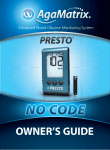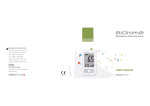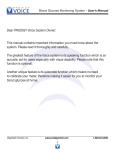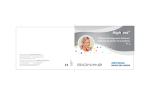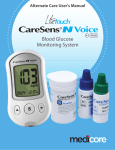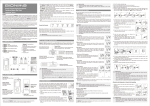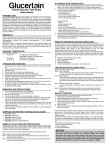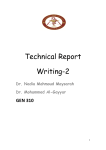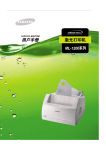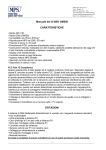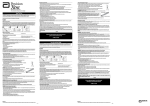Download GS550 Test Strip Insert(GD500 AST)-EN(US)-未轉曲線
Transcript
Rightest™ GS550 BLOOD GLUCOSE TEST STRIP INSERT Intended Use The Rightest™ Blood Glucose Monitoring System is used by diabetics. It's for checking on glucose levels in capillary whole blood (CB) from the fingertip, palm and forearm. It's as an aid in management of diabetes at home and clinical sites. Rightest™ Blood Glucose Test Strips are intended for testing outside the body (in vitro diagnostic use for self-testing only). Rightest™ System tests the CB and offers results equivalent to a lab instrument (Plasma equivalent). Rightest™ Blood Glucose Test Strip GS550 is designed for use only with Rightest™ Blood Glucose Meter GM550 to get accurate results. Rightest™ Blood Glucose Monitoring System includes meter, test strips, control solutions, lancing device and lancets. Test Procedure Preparing the Lancing Device 1) Pull off the depth adjustable cap. 2) Insert a new disposable lancet firmly into lancet carrier. 3) Twist off and set aside the protective cover of the disposable lancet. 4) Replace the depth adjustable cap. 5) Choose a depth of penetration by rotating the top portion of the depth adjustable cap until the setting depth matches the window. Settings are based on skin type " " for soft or thin skin; " " for average skin; " " for thick or calloused skin. 6) Hold the hub in one hand and pull on the plunger in the other hand. The device will be cocked. Release the plunger, it will automatically move back to its original position near the hub. 1 2 4 3 5 6 Performing a Test 1) Wash your hands with warm soapy water and dry thoroughly. 2) Take one test strip from the vial. Re-cap the vial cap immediately. 3) Insert the strip into the strip port of the meter with the indication symbol facing up. Push the strip in until it snaps and stops. The meter will turn on automatically. 4) While the blood drop symbol is flashing, you are ready to apply the blood sample within 2 minutes. 5) Place the lancing device against the pad of your fingertip and press the release button. 2 1 3 4 5 GM550 Sample Size Example 1.0µl 1.5µl 2.0µl 3.0µl 4.0µl Please take a minimum of 1.0uL to do the test on glucose monitoring system. Blood sample size above 3.0uL might contaminate the test strip port and the meter. Alternative site testing-palm or forearm blood sampling - To perform a test using samples obtained from alternative sites, install the clear cap on the lancing device. (For more inforamtion on how to install, see the lancing device manual). - To increase the blood flow, massage the puncture area of palm or forearm for a few seconds. - Immediately after massaging the puncture area, press and hold the lancing device with the clear cap against palm or forearm. - Then press the release button. - Continue holding the lancing device against palm or forearm and gradually increase pressure for a few seconds until the blood sample size is sufficient. ( Refer to Instruction manual for the lancing device ) Releasing button Pressing for a few seconds 6) Touch and hold the drop to the edge of sample entry until you hear a " beep " (if volume is turned on) and the View Window is totally filled with blood. If the View Window is not totally filled with blood or the test does not start, please discard the test strip and repeat the test with a new test strip. 7) You will see the countdown mode on the screen. After 5 seconds, the test result appears. 8) Remove the test strip from the meter. Please follow the local regulation and discard the used strip properly. 9) To remove the lancet, pull off the depth adjustable cap of lancing device. Without touching the used disposable lancet, stick the lancet tip into the protective cover. Hold the release button of lancing device in one hand and pull on the plunger in the other hand will safely eject the used disposable lancet into an appropriate puncture-proof or biohazard container. 6 8 G M 55 0 7 GM550 For more information on how to use your meter and understand your test results, see the User manual. Test Result - Blood glucose test results are shown on the meter as mg/dL. - If your blood glucose result is unusually high or low, or if you question your results, repeat the test with a new test strip. You can also run a Quality Control Test with the Rightest™ Control Solutions to check your meter and Test Strip. If the test result still remains unusually high or low, contact your doctor immediately. - If you are experiencing symptoms that are not consistent with your blood glucose test results and you have followed all the instructions in this manual, contact your doctor immediately. - The Rightest™ Meter displays results between 20 and 600 mg/dL. If your test result is below 20 mg/dL, " Lo " will appear on the screen. Please repeat your test with a new strip. If you still get a " Lo " result, you should immediately contact your doctor. - If your test result is above 600 mg/dL, " Hi " will appear on the screen. Please repeat your test with a new strip. If you still get a " Hi " result, you should immediately contact doctor. Expected glucose values without diabetes Status Fasting (1) Range (mg/dL) 70 – 99 Precautions - Check the expiration date printed on the strip vial. Do not use expired test strips. - Close the vial cap immediately after taking test strip out from the vial. - Do not perform quality control test with expired control solution. - Do not bend or twist the test strip. Damage of test strip may cause wrong result. - Do not reuse test strips. - Do not reuse lancets. Discard used lancets properly. - If the Rightest™ meters and strips are exposed to a high temperature difference, please wait 30 minutes before measurement. - If you want to purchase new normal or high level control solutions, please contact your authorized Bionime representative. - The glucose test results of blood samples taken from different sites might be varied in certain conditions such as your glucose is changing rapidly following a drink, a meal, an insulin dose or exercise. In these cases, only fingertip should be used. Warning - Keep the test strips or vial cap away from children. They may cause a choking hazard. If a test strip or vial cap is swallowed, contact your doctor instantly. Limitations - Grossly lipemic ( fatty ) samples may influence the test results. Knowing such interferences, patients under the supervision of their doctor should have baseline glucose values set up by a clinical lab method before the start of glucose monitoring at home. These baseline values should be checked regularly. - The meter readings of the blood glucose may be significantly lower than " true glucose levels " in the hyperglycemichyperosmolar state, with or without ketosis. Critically ill patients should not be tested by the Rightest™ System, or tested with extreme caution. - Caution is advised when glucose values are below 50 mg/dL or above 250 mg/dL. Consult a doctor as soon as possible, if values in this range are obtained. - Healthcare professionals should evaluate their technique and their patients' technique at periodic intervals. To accomplish this, it is recommended that BGM results be compared with a concurrently obtained laboratory measurement on the same blood sample. A well characterized clinical laboratory method employing hexokinase or glucose oxidase should be used as the comparative method. - Flouoride should not be used as a preservative when collecting blood glucose samples. - Hands and fingers contaminated with sugar from foods or beverages may cause false elevated results. - The results of blood glucose measurements are different for measurements with whole blood and plasma. - Storage of strips near bleach as well as bleach containing products will affect the results of the Rightest™ Test Strips. - Rightest™ Blood Glucose Test Strips are designed for use with capillary whole blood samples. Do not use serum or plasma samples. - Incorrect test results may be obtained at high altitude more than about 3048 meters (10000 feet) above sea level. - Hematocrits below 30% may cause higher results, and hematocrits above 60% may cause lower results. - Severe dehydration and excessive water loss may cause inaccurately low results. - Rightest™ Blood Glucose Monitoring System has not been validated for use on neonates. Therefore, it should not be used for neonates. - Do not perform the blood glucose test at temperatures below 10℃ (50℉ ) or above 40℃ (104℉ ), below 10% or above 90% relative humidity. - Not intended for screening or diagnosis of diabetes or for use on neonates. - Inaccurate results may occur in severely hypotensive individuals or patients in shock. NOTE - Suggest not to use this meter close to source of strong electromagnetic radiation, to avoid interference with proper operation. - Suggest to keep meter free of dust, water or any liquid. Storage and Handling - Store the strips in the original capped vial at temperatures between 4℃ to 30℃ (39 to 86℉ ) and relative humidity below 90%. Do not freeze. - Replace the vial cap immediately and close tightly after taking test strip out from the vial. Do not leave the cap of vial opened. If the strip is exposed to the air too long, it will absorb the moisture and cause wrong test result. - When you open a new vial of test strips please write the opening date on the label. Use test strips within 3 months after first opening or until the expiration date printed on the label (whichever comes first). Measurement Range The measurement range of the Rightest™ System is 20 to 600 mg/dL. Quality Control Section Please refer to the Quality Control section of the User Manual. Troubleshooting and Customer Service For more information on error messages and trouble shooting, please refer to the Error Messages and Trouble Shooting section of the Rightest™ User Manual. You may also contact customer service by calling toll free at 1 (888) 481-8485 (Monday through Friday 8:00 AM to 5:00 PM PST). ( At all other times, you could contact your healthcare professional for help ) Additional Information for Healthcare Professionals (2) Detection Principle The glucose oxidase and potassium ferricyanide in the strip react with the glucose in the sample to produce an electrical current which is proportional to the amount of glucose in the sample. The meter measures the current and converts it to the corresponding glucose concentration. Performance Characteristics Measurement Range The measurement range of the Rightest™ System is 20 to 600 mg/dL. Precision The precision was evaluated with 5 levels glucose control solution in 20 days by 5 meters and 2 batches of strip. # Control solution: a. Same glucose level (normal level) for 5 meters Meters (1) Mean (mg/dL) (2) Total test numbers (n) (3) SD (mg/dL) (4) CV (%) b. 5 glucose levels for same meter Glucose levels (1) Mean (mg/dL) (2) Total test numbers (n) (3) SD (mg/dL) (4) CV (%) I 104.4 80 3.0 2.8 II 104.1 80 2.8 2.7 III 103.7 80 2.5 2.4 IV 103.8 80 2.4 2.3 V 104.8 80 2.6 2.4 A 40.9 80 1.3 3.1 B 104.4 80 3.0 2.8 C 137.9 80 3.6 1.9 D 210 80 4.0 1.9 E 290.5 80 5.7 1.9 Accuracy For the alternative site: The accuracy of the alternative site test study of Rightest™ System was proved by comparing whole blood (plasma equivalent) glucose values on the Rightest™ meter with plasma glucose values on a lab instrument. A total of 114 patients joined. Each collected and tested their own blood samples (from the fingertip, palm and forearm) with Rightest™ meter. Another blood sample was collected within 5 minutes and got the plasma. Analyze the plasma by the lab instrument. 97% of Rightest™ meter values were within ± 20% of the Olympus values at glucose concentrations ≧75 mg/dL and within ±15 mg/dL at glucose concentrations<75 mg/dL. The Results and differences between the two methods, Rightest™ System and Olympus 2700 (as the reference method) are proved in the tables below. Table 1: represents samples for glucose results lower than 75 mg/dL. Difference range in values between the Olympus value and the Rightest™ meter value The percent ( and number ) of samples for which the difference between the Rightest™ meter value ( Alternative site ) and the Olympus value were within the difference range shown in the side row. Fingertip Palm Forearm Within ± 5 mg/dL 78.9% (15/19) 78.9% (15/19) 42.1% (8/19) Within ± 10 mg/dL 100% (19/19) 94.7% (18/19) 78.9% (15/19) Within ± 15 mg/dL 100% (19/19) 100% (19/19) 94.7% (18/19) Table 2: represents samples for glucose results greater than 75 mg/dL. Difference range in values between the Olympus value and the Rightest™ meter value The percent ( and number ) of samples for which the difference between the Rightest™ meter value ( Alternative site ) and the Olympus value were within the difference range shown in the side row. Fingertip Forearm Palm Within ± 5% 55.8% (53/95) 55.8% (53/95) 49.5% (47/95) Within ± 10% 75.8% (72/95) 75.8% (72/95) 71.6% (68/95) Within ± 15% 91.6% (87/95) 89.5% (85/95) 91.6% (87/95) Within ± 20% 96.8% (92/95) 96.8% (92/95) 97.9% (93/95) * Acceptance criteria in ISO15197 are that 95% of all differences in glucose values should be within ±15 mg/dL for glucose values less than 75 mg/dL, and within ±20% for glucose values greater than 75 mg/dL. Note: When glucose meter results are compared to the laboratory results, difference values below 75 mg/dL are expressed in mg/dL, while those above 75 mg/dL are compared in percent. Interferences The following compounds may interfere with the glucose measurement at the concentrations listed: Uric acid ≧ 16 mg/dL NOTE Acetaminophen, Ascorbic acid (Vitamin C), Dopamine, Ibuprofen, L-Dopa, Methyldopa, Salicylic Acid, Tetracycline, Tolbutamide, Bilirubin-conjugated, Cholesterol, Creatinine, Triglyceride, Maltose, Xylose, Galactose and Lactose ( when occurring in normal blood or normal therapeutic concentrations ) do not significantly affect results. However, abnormally high concentrations in blood may cause inaccurate results. Reagents Each Blood Glucose Test Strip contains the following reagents: Glucose Oxidase (Aspergillus niger) (GOD) 14.8% Potassium ferricyanide 39.5% Non-reactive ingredients 45.7% References 1) Diabetes Information - American Association for Clinical Chemistry (AACC)〔Electronic Version〕Retrieved February 08, 2006 from www.labtestsonline.org/understanding/analytes/glucose/test.html 2) In Vitro Diagnostics in Diabetes : Meeting the Challenge. Clinical Chemistry 45:9, 1596-1601 (1999). 0197



